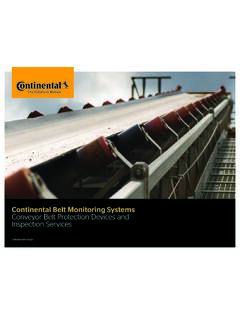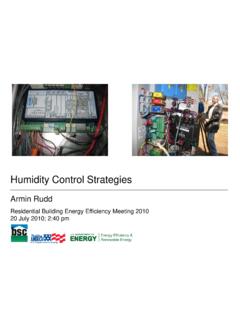Transcription of CMS Manual System
1 CMS Manual System Department of Health & Human Services (DHHS) Pub. 100-07 State Operations Provider Certification Centers for Medicare & Medicaid Services (CMS) Transmittal 99 Date: January 31, 2014 Transmittal 89, dated August 30, 2013, is being rescinded and replaced by Transmittal 99, dated January 31, 2014, to include Appendix I erroneously omitted. All other information remains the same. SUBJECT: Revised State Operations Manual (SOM) Appendices A, I, L, and W I. SUMMARY OF CHANGES: Clarification is provided in the SOM appendices for permitting certain new and existing health care facility ventilation systems to operate at a relative humidity equal to or greater than 20 percent, in accordance with the 2012 edition of NFPA 99, Health Care Facilities and the referenced 2008 edition of ASHRAE Standard 170, Ventilation of Health Care Facilities, Addendum D.
2 NEW/REVISED MATERIAL - EFFECTIVE DATE*: January 31, 2014 IMPLEMENTATION DATE: January 31, 2014 The revision date and transmittal number apply to the red italicized material only. Any other material was previously published and remains unchanged. However, if this revision contains a table of contents, you will receive the new/revised information only, and not the entire table of contents. II. CHANGES IN Manual INSTRUCTIONS: (N/A if Manual not updated.) (R = REVISED, N = NEW, D = DELETED) (Only One Per Row.) R/N/D CHAPTER/SECTION/SUBSECTION/TITLE R Appendix A/Standard: Facilities/ (c)(4) There must be proper ventilation, light, and temperature controls in pharmaceutical, food preparation, and other appropriate areas/A-0726 R Appendix I/Survey Procedures for Life Safety Code Surveys R Appendix L/ (a)(1) Standard: Physical Environment/Q-0101 R Appendix W/ (b)(5) Standard: Maintenance/C-0226 III.
3 FUNDING: No additional funding will be provided by CMS; contractor activities are to be carried out within their FY 2011 operating budgets. IV. ATTACHMENTS: Business Requirements X Manual Instruction Confidential Requirements One-Time Notification Recurring Update Notification State Operations Manual Appendix A - Survey Protocol, Regulations and Interpretive Guidelines for Hospitals 0726 ( Issued: 01-31-14, Effective: 01-31-14, Implementation: 01-31-14) (c)(4) - There must be proper ventilation, light, and temperature controls in pharmaceutical, food preparation, and other appropriate areas. Interpretive Guidelines (c)(4) There must be proper ventilation in at least the following areas: Areas using ethylene oxide, nitrous oxide, guteraldehydes, xylene, pentamidine, or other potentially hazardous substances; Locations where oxygen is transferred from one container to another; Isolation rooms and reverse isolation rooms (both must be in compliance with Federal and State laws, regulations, and guidelines such as OSHA, CDC, NIH, etc.)
4 ; Pharmaceutical preparation areas (hoods, cabinets, etc.); Laboratory locations; and Anesthetizing locations. According to NFPA 99, anesthetizing locations are Any area of a facility that has been designated to be used for the administration of nonflammable inhalation anesthetic agents in the course of examination or treatment, including the use of such agents for relative analgesia. NFPA 99 defines relative analgesia as A state of sedation and partial block of pain perception produced in a patient by the inhalation of concentrations of nitrous oxide insufficient to produce loss of consciousness (conscious sedation). (Note that this definition is applicable only for LSC purposes and does not supercede other guidance we have issued for other purposes concerning anesthesia and analgesia.)
5 There must be adequate lighting in all the patient care areas, and food and medication preparation areas. Temperature, humidity and airflow in anesthetizing locations must be maintained within acceptable standards to inhibit microbial growth, reduce risk of infection, control odor, and promote patient comfort. Hospitals must maintain relative humidity (RH) levels at 35 percent or greater in each anesthetizing location, unless the hospital elects to use the CMS categorical waiver, which permits it to maintain a RH of at least 20 percent (see Appendix I, Section II for additional information). Hospitals must maintain records that demonstrate they have achieved the required levels. Although not required, CMS recommends that hospitals maintain the upper range of RH at 60 percent or less, as excessive humidity is conducive to microbial growth and compromises the integrity of wrapped sterile instruments and supplies.
6 Each operating room should have separate temperature control. Acceptable standards such as from the Association of Operating Room Nurses (AORN) or the Facilities Guidelines Institute (FGI) should be incorporated into hospital policy. The hospital must ensure that an appropriate number of refrigerators and/or heating devices are provided and ensure that food and pharmaceuticals are stored properly and in accordance with nationally accepted guidelines (food) and manufacturer s recommendations (pharmaceuticals). Survey Procedures (c)(4) Verify that all food and medication preparation areas are well lighted. Verify that the hospital is in compliance with ventilation requirements for patients with contagious airborne diseases, such as tuberculosis, patients receiving treatments with hazardous chemical, surgical areas, and other areas where hazardous materials are stored.
7 Verify that food products are stored under appropriate conditions ( , time, temperature, packaging, location) based on a nationally-accepted source such as the United States Department of Agriculture, the Food and Drug Administration, or other nationally-recognized standard. Verify that pharmaceuticals are stored at temperatures recommended by the product manufacturer. Review monitoring records for temperature to ensure that appropriate levels are maintained. Review humidity maintenance records for anesthetizing locations to ensure, if monitoring determined humidity levels were not within acceptable parameters, that corrective actions were performed in a timely manner to achieve acceptable levels. State Operations Manual Appendix I Survey Procedures for Life Safety Code Surveys ( Issued: 01-31-14, Effective: 01-31-14, Implementation: 01-31-14) I.
8 Introduction II. The Survey Tasks Task 1 Offsite Survey Preparation Task 2 - Entrance Conference/Onsite Preparatory Activities Task 3 - Orientation Tour Task 4 - Information Gathering Task 5 - Information Analysis and Decision Making Task 6 - Exit Conference III. Complaint Investigations IV. Post Survey Revisits I. Introduction Use the survey procedures in this appendix section for all Life Safety Code (LSC) surveys (initial and recertification) of facilities subject to Survey and Certification inspections for Medicare/Medicaid certification. This includes, but is not limited to, Skilled Nursing Facilities (SNFs), Nursing Facilities (NFs) whether freestanding, distinct parts, or dually certified, Intermediate Care Facilities for Individuals with Intellectual Disabilities ( ICFs/IID), Ambulatory Surgical Centers (ASC), inpatient Hospice facilities, Program for All inclusive Care for the Elderly (PACE) facilities, Critical Access Hospitals (CAH), Psychiatric and General Hospitals, including validation surveys of accredited facilities.
9 These procedures also apply to complaint investigations. When conducting LSC complaint investigations, focus your review on those requirements relevant to the complaint. All SNF/NF and ICFs/IID surveys must be unannounced. The LSC survey of a SNF/NF may precede the survey of resident care requirements and can be done independent of a health survey. LSC surveys must be conducted and completed on consecutive days. Survey team members need not be onsite for the entire survey. For example special consultants participating in the survey (such as, a fire protection engineer, or fire alarm technician) have the option of being onsite only during that portion of the survey that require their area of expertise; however, they must conduct that portion while the rest of the LSC survey team is present.
10 The special consultant(s) should present their findings to the team or team leader before departing the facility. If any deficiencies are to be cited, supporting documentation should be left with the team. The consultant should be available during the exit conference to supply any additional information required. This can be in-person or by telephone. II. The Survey Tasks Task 1 Offsite Survey Preparation The surveyor or survey team will review the facility file for: Recent licensure and/or certification surveys, including any deficiencies from the previous, bed capacity, change in ownership, facility waivers; Corrective action status (if applicable); Complaint investigations; Facility floor plans, including the location of individual rooms, exits and commons areas; and Correspondence to or from the SA and the facility.
















